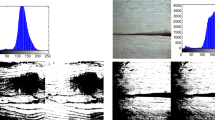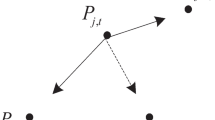Abstract
Image segmentation, an indispensable stage of digital image processing for computer vision, plays an important role in linking up of image processing, image recognition and image analysis. The blanket fractal dimension method can help segment images with irregular objects, and has been used in different fields. Morphology is an important method in processing images through using erosion operation, dilation operation, opening operation and closing operation, which help perfect incomplete edges or contours of objects to a certain extent. The traditional fractal dimension method is poor in segmenting irregular objects from a complex background because it cannot distinguish the close grayscale between the objects and the complex background besides different sizes of the objects, which are easy to cause under-segmentation. To improve the segmentation effect, an improved image segmentation method based on bit-plane and morphological reconstruction is proposed in the present work. The traditional blanket fractal dimension method is used to make a coarse segmentation of the pending images, and the coarse segmented results are further improved through using bit-plane and morphological reconstruction. The reconstruction role is to compensate the missing features and eliminate the invalid features. Based on the fine segmented results carried out in the experiments, it is found that the proposed method can obtain more accurate segmentation effect than the traditional methods in image processing.







Similar content being viewed by others
References
Atkociunas E, Blake R, Juozapavicius A, Kazimianec M (2005) Image processing in road traffic analyses. Nonlinear Anal Model Control 10(4):315–332
Baba N, Ichse N, Tanaka T (1996) Image area extraction of biological objects from a thin section image by statistical texture analysis. J Electron Microsc 45:298–306
Chen SL, Huang YQ, Zhang H, Yang XX, Guo H (2014) Application of fractal theory on identification of near-surface defects in ultrasonic A-scan detection. J Comput Appl 34(11):3365–3368
Deng X, Li JL, Feng FJ, Wang L, Yu ZM (2016) An image segmentation algorithm based on gray bit plane for flame. Adv Comput Sci Res 50:365–369
Gong JF, Xu XP (2006) 3-D surface reconstruction of grinding wheel topography based on depth from focus. J Diam Abra Eng 154(4):14–16
Gonzalez RC, Woods RE (2007) Digital image processing, 2nd edn. Pearson Education, Upper Saddle River
Guo HG, Jun QU (2014) Clustering segmentation of Ferrography based on Gabor transform and fractal fearture. J Chin Comput Syst 35(6):1392–1395
Guo HG, Qu J (2014) Clustering segmentation of ferrography based on gabor transform and fractal feature. J Chin Comput Syst 35(6):1392–1395
Hemachande S, Verma A, Arora S, Panigrahi PK (2007) Locally adaptive block thresholding method with continuity constraint. Pattern Recogn Lett 28:119–124
Huang P, Jia MP, Zhong BL, Hu XG (2006) Micromorphology analysis and automatic identification technique for wear particles. J Southeast Univ 36(3):411–415
Huang SG, Duan N, Chen X, Yu YQ, Xu XP (2013) Image mosaic coupled detection of grinding wheel topographies. Int J Abras Technol 6(6):147–157
Kang CC, Wang WJ (2007) A novel edge detection method based on maximization of the objective function. Pattern Recogn 40(2):609–618
Keller JM, Chen S, Crownover RM (1989) Texture description and segmentation through fractal geometry. Comput Vis Graph Image Proc 45(2):150–166
Kisan S, Mishra S, Rout SB (2017) Fractal dimension in medical image: a review. Int Res J Eng Technol 4(5):1102–1106
Li H, Manjunath B, Mitra SK (1995) A contour-based approach to multi sensor image registration. IEEE Trans Image Proc 4(3):320–334
Lin YF, Wu F, Fang CF (2015) Wear feature extraction for diamond abrasive based on image processing techniques. In: Proceedings of the International Conference on Energy, Environment and Materials Science (EEMS), p 823–827
Liu Y, Li M, Mao L (2006) An algorithm of multi-spectral remote sensing image segmentation based on edge information. J Remote Sens 10(3):350–356
Liu YN, Zhong Q, Chang CC (2017) A novel image protection scheme using bit-plane compression and secret sharing strategies. J Chin Inst Eng 40(2):161–169
Miao Q, Ding WF, Xu JH, Yang CY, Fu YC (2013) Fractal analysis of wear topography of brazed polycrystalline CBN abrasive grains during grinding nickel super alloy. Int J Adv Manuf Technol 68(9-12):2229–2236
Nguyen TD, Arch-int S (2016) An adaptive multi bit-plane image steganography using block data-hiding. Multimed Tools Appl 75:8319–8345
Oommen RS, Jayamohan M, Sruthy S (2016) Using fractal dimension and singular values for image forgery detection and localization. Procedia Technol 24(1):1452–1459
Peleg S, Naor J, Hartley R, Avnir D (1984) Multiple resolution texture analysis and classification. IEEE Trans Pattern Anal Mach Intell 6(4):518–523
Pentland AP (1984) Fractal-based description of natural scenes. IEEE Trans Pattern Anal Mach Intell 6(6):661–674
Ricotta C, Avena GC, Olsen ER, Ramsey RD, Winn DS (2018) Monitoring the landscape stability of Mediterranean vegetation relation to fire with a fractal algorithm. Int J Remote Sens 19(5):871–881
Song HR, Chen GM, Jiang LZ (2007) Research on the techniques about identification of wear particles based on fractal dimension. Chin J Sci Instrum 28(4):467–471
Sun TZ, Zhang W, Wang ZJ, Ma L, Jie ZQ (2018) Image-level to pixel-wise labeling: from theory to practice. In: Proceedings of the Twenty-Seventh International Joint Conference on Artificial intelligence (IJCAI), p 928–934
Wu T (2014) Adaptive rough entropy method for image thresholding. J Image Graph 19(1):1–10
Wu WY, Cui CC, Ye RF, Zhang YZ, Yu Q (2016) Image segmentation method using second time gray level histogram of connected component labeling of grinding wheel abrasives grains. J Huaqiao Univ 37(4):422–426
Wu YP, Peng XQ, Ruan K (2017) Improved image segmentation method based on morphological reconstruction. Multimed Tools Appl 76(19):19781–19793
Zahouani H, Mansori ME (2017) Multi-scale and multi-fractal analysis of abrasive wear signature of honing process. Wear 376-377:178–187
Zhang W, Cham WK (2012) Gradient-directed multiexposure composition. IEEE Trans Image Process 21(4):2318–2323
Zhang LP, Li GY, Yu CM, Li H (2011) Improvement of tissue contour extraction method in medical image. Comput Simulat 28(3):271–270
Zhang SS, Liu Y, Zhao ZB (2015) Fractal image retrieval algorithm based on contiguous-matches. Comput Sci 42(12):292–311
Zhang WD, Zhang W, Liu K, Gu J (2017) Learning to predict high-quality edge maps for room layout estimation. IEEE Trans Multimedia 19(5):935–943
Zhang W, Chen Q, Zhang WD, He XY (2018) Long-range terrain perception using convolutional neural networks. Neurocomputing 275:781–787
Zhu Y, Li XB (2016) Environmental image edge detection using improved multifractal method. Comput Appl Software 33(8):221–224
Acknowledgments
The authors would like to thank the financial support of the projects from the National Natural Science Foundation of China (Grant No. 51675193), the project of Distinguished Young Scientific and Technological Talents in Fujian Provincial Higher Institutions (2017), the project of Natural Science Foundation of Fujian Province (Grant No. 2016 J01235), and the project of Fujian Provincial Department of Education of China (Grant No. JAT160633).
Author information
Authors and Affiliations
Corresponding author
Additional information
Publisher’s Note
Springer Nature remains neutral with regard to jurisdictional claims in published maps and institutional affiliations.
Rights and permissions
About this article
Cite this article
Lin, Y., Wu, L. Improved abrasive image segmentation method based on bit-plane and morphological reconstruction. Multimed Tools Appl 78, 29197–29210 (2019). https://doi.org/10.1007/s11042-018-6687-9
Received:
Revised:
Accepted:
Published:
Issue Date:
DOI: https://doi.org/10.1007/s11042-018-6687-9




